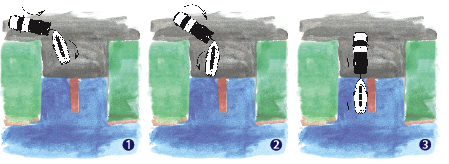Backing up a trailer
2010 May 1
For most of us, backing a boat and trailer down a launch is not the most pleasant experience. Like sailing into a dock, it seems everyone is watching you, waiting for you to make a mistake.

Before you head to the boat launch, it's a good idea to practice backing up the trailer. Head to an empty parking lot to hone your skills, backing the trailer to both the right and left. You can use the parking space strips to help visualize the launch ramp-when you can confidently back the trailer straight through the lines from any starting angle you're good to go.
Once at the launch, the first thing you should do is look up. Look for any power lines, trees or other overhead obstruction that can snag the mast and rigging. Doing this before stepping the mast can save some hassles, not to mention the possible damage to boat and body.
Approach the launch from the left (driver's) side if possible. This will let you better see the trailer from the driver's side mirror as you back down, and you'll be able to see the end of the trailer by looking over your shoulder. Of course backing in a straight line is easier than backing at sharp angles, so try to get the vehicle and trailer as straight as possible, even if this means pulling far forward.
When you're ready to back up, put one hand on the bottom of the wheel, at the 6 o'clock position, and turn your head and body to watch the trailer behind you. With your hand at the bottom of the wheel, all you need to do is turn it in the direction you want the trailer to go-moving your hand to the right (turning the wheel left) will move the trailer to the right and vice versa.
As you back down don't let the trailer swing too far to the left or right; you don't want to jackknife the vehicle and trailer. Don't be shy about stopping to get out and look at the situation. Don't feel rushed. It's better to take your time and do it right than damage your boat, or worse, someone else's.
Approaching the ramp from the driver's side will better help you see the boat and trailer. Small, smooth movements are the way to go, preventing the trailer from swinging too far out of position.

Before you head to the boat launch, it's a good idea to practice backing up the trailer. Head to an empty parking lot to hone your skills, backing the trailer to both the right and left. You can use the parking space strips to help visualize the launch ramp-when you can confidently back the trailer straight through the lines from any starting angle you're good to go.
Once at the launch, the first thing you should do is look up. Look for any power lines, trees or other overhead obstruction that can snag the mast and rigging. Doing this before stepping the mast can save some hassles, not to mention the possible damage to boat and body.
Approach the launch from the left (driver's) side if possible. This will let you better see the trailer from the driver's side mirror as you back down, and you'll be able to see the end of the trailer by looking over your shoulder. Of course backing in a straight line is easier than backing at sharp angles, so try to get the vehicle and trailer as straight as possible, even if this means pulling far forward.
When you're ready to back up, put one hand on the bottom of the wheel, at the 6 o'clock position, and turn your head and body to watch the trailer behind you. With your hand at the bottom of the wheel, all you need to do is turn it in the direction you want the trailer to go-moving your hand to the right (turning the wheel left) will move the trailer to the right and vice versa.
As you back down don't let the trailer swing too far to the left or right; you don't want to jackknife the vehicle and trailer. Don't be shy about stopping to get out and look at the situation. Don't feel rushed. It's better to take your time and do it right than damage your boat, or worse, someone else's.
Approaching the ramp from the driver's side will better help you see the boat and trailer. Small, smooth movements are the way to go, preventing the trailer from swinging too far out of position.

Comments